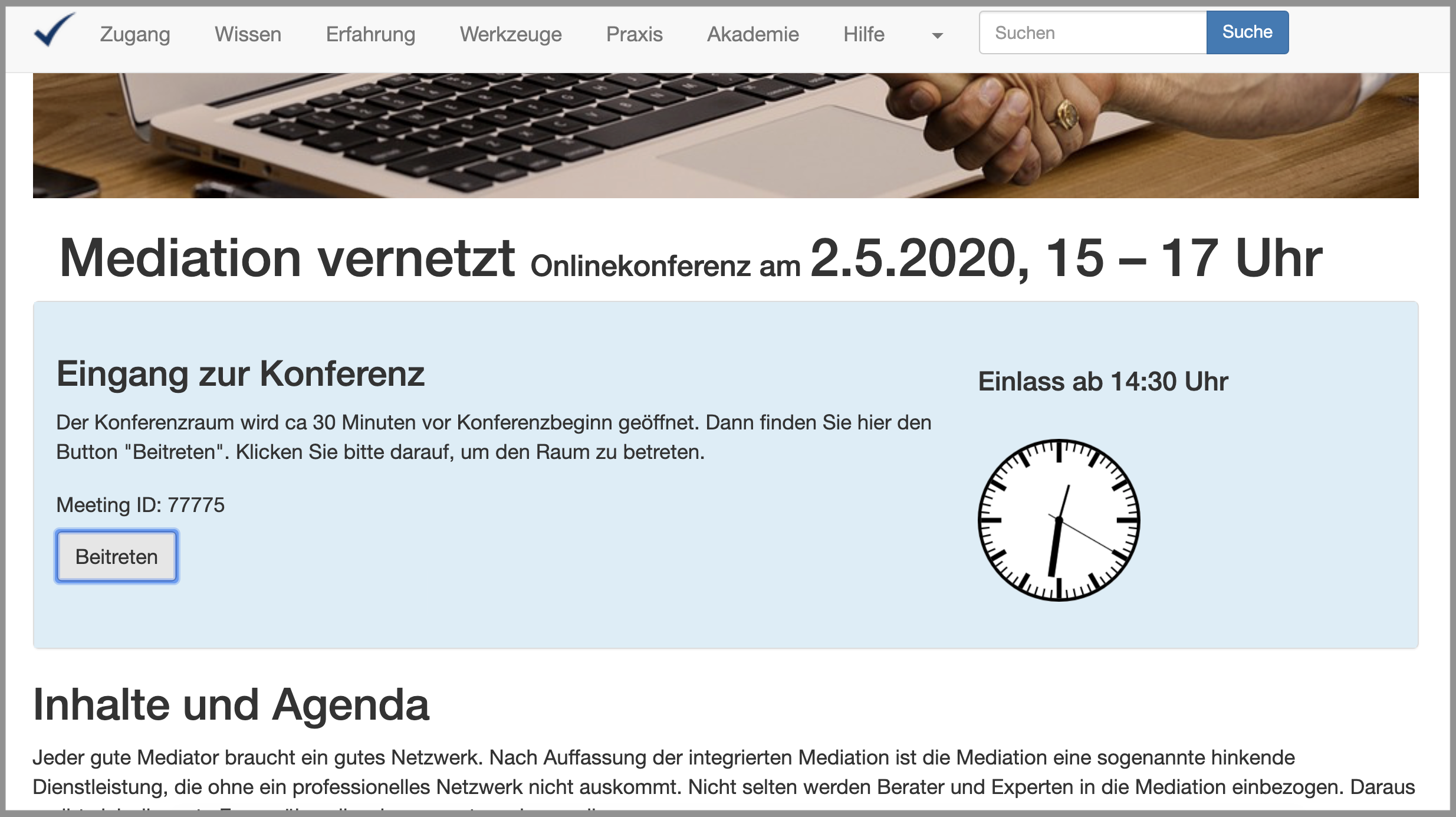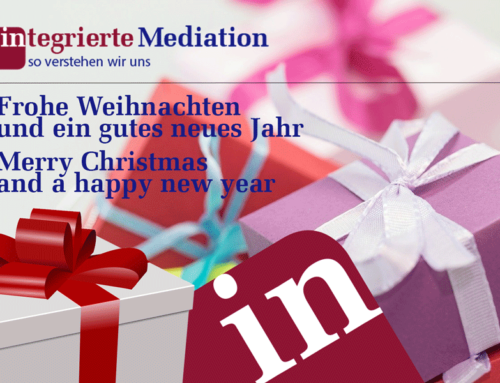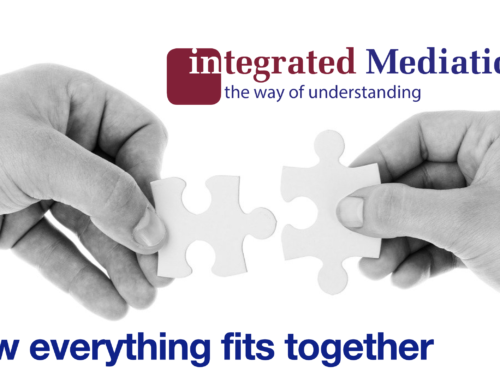On May 2nd, 2020, 53 participants met for the first online conference of integrated mediation on the Internet. The screenshot shows the entrance to the conference. From the point of view of the organizer, the association of integrated mediation, the attempt to meet online in a larger context was a first important trial and a first success. Participants agreed that there should be other such conferences in future. We found out, that there are also other options for using online technology in our association.
Feedback such as “Thank you very much, that was very interesting”, “Thank you very much for the opportunity to participate – very interesting discussion!”, “Great conference and gladly again – thanks to all speakers” give the picture and the impression from the circle of participants representative and best again. The conference opened punctually at 3:00 p.m. and lasted until 5:25 p.m. as scheduled. Participants were members who otherwise had a long trip for coming’s g together. Since this was a first trial, we kept the conference small and limited to German speaking members.
Content and Speakars
After an introduction by the chair, the speakers had the opportunity to present their topic. It started with the 2nd chair, Katharina Reinhold (mediator and lawyer). She reported on experiences in working with associations and their interest in mediation. The need to network especially with associations that have no original contact to mediation was emphasized. The means for networking could be online tools, information and support for associations i.e. in the field of tourism, school, care, etc.
Board member Roland Zargens (lawyer in the area of major personal injury) explained the example of networking with the rehabilitation service provider RehaAssist. His focus was on the need for communication between the parties involved, who are around the injured party and who act from different areas with different legal requirements and various options. They need to be harmonized, where integrated mediation. is a tool. Our cooperation agreement agreed with RehaAssist is a good example of successful networking.
In the discussion with participants, the topic of networking was linked to the question of how the mediator can get orders. In-house training was a suggestion. Correct information is still important. Many do not know what mediation is capable of. The association makes a lot of efforts to provide correct information about mediation. In addition to events and publications, it supports Wiki to Yes, which is now the largest interactive and freely accessible database for mediation. An important issue for contract awarding is getting the opponent to the table. Networking with first consultants, such as lawyers and therapists, are an important approach. The prerequisite is that the boundaries of the services are recognized and that there is a need for supplementation, for example for mediation.
Kay Kretschmer (mediator and manager) was introduced as a project manager for bringing together the expert knowledge hidden in the club. Taken as a whole, the total number of members covers all of the specialist knowledge relating to conflict resolution. Their expertise is often not recognizable. The speaker presented the new project, where the first step is to explore the technical possibilities of networking on the Internet. The mediator directory plays an important role, so that the search for experts within the mediator network of integrated mediation is not only improved for internal purposes.
Ms. Helga Koenemann (chairwoman of the parliamentary group and city councilor CDU Neuss) reported on the possibilities and opportunities of mediation in local politics. The focus was on mediation as a process. In response to the allegation that political communication starts from thinking in a zero-sum game and is used to badly talk to the opponent instead of finding constructive solutions, the speaker said that approx. 80-85% of the decisions by agreement and across party borders done beyond. The press would like to highlight and polarize contradictions. One participant contested that, in his perception, political thinking appears more problem-oriented and opinion-political than mediative. Integrated mediation as a cognitive process could help. It was also interesting to note from one participant that a ministry referred to the free advice of a mediator’s association. The information confused the participants insofar as the association of integrated mediation offers the same service (see first aid), which is probably even more prominent but not recommended by the ministry.
In an impressive presentation, Monika Zielinsi-Bülte (mediator, doctor, head of the medicine department) revealed how important it is to network with other professions and that the competition in shared use must be redirected so that it does not stand in the way of networking. The Coopetition (artificial word from cooperation and competence) was presented in the context as a model that represents a combination of meaningful cooperation (in the development of products) and the competition limited to sales. It was recognized that competition places ethical requirements that prevent customers from being enticed. Ethics is part of the training in integrated mediation. It should also be anchored in the association’s standards.
Anna Klatt (mediator, board member and social media manager in the association) reported on the presence of the association on Instagram, Facebook, Twitter, etc. and the need for networking also via social media.
On behalf of Hans-Christian Reichel (Board of Directors, responsible for contact with associations and authorities), Arthur Trossen explained the planning for the mediator’s conference of the BMJV (Ministery of Justice). He regretted that such a conference, which enables the exchange of more than 5 associations, was to be welcomed.
Results
The online tool was subjected to an initial endurance test and has proven itself. BigBlueButton is qualitatively equivalent to Zoom.us and more secure because it is installed on a separate server of the association and is therefore not externally controlled. In addition, the tool can be put to the benefit of all members, which meets the requirements of a non-profit association. The technology provides all the features that an online conference requires. The number of participants occurred to not be a problem. Some participants use the chat feature to add information (such as links) to the speaker contributions. In the case of individual problems (such as technical questions), an individual chat is possible. The course of the conference was recorded on a flipchart accessible to everyone.
Of course, online communication has limitations. This might be respected in a different format of further online conferences. On the other hand, it opens up opportunities that are not available at a presence conference. The voices to repeat such online conferences regularly at shorter intervals with specific topics became louder. We will answer the call. The Round Table and Question Time at Wiki to Yes already provide an opportunity for this. See https://www.wiki-to-yes.org/Meetings)






Leave A Comment
You must be logged in to post a comment.